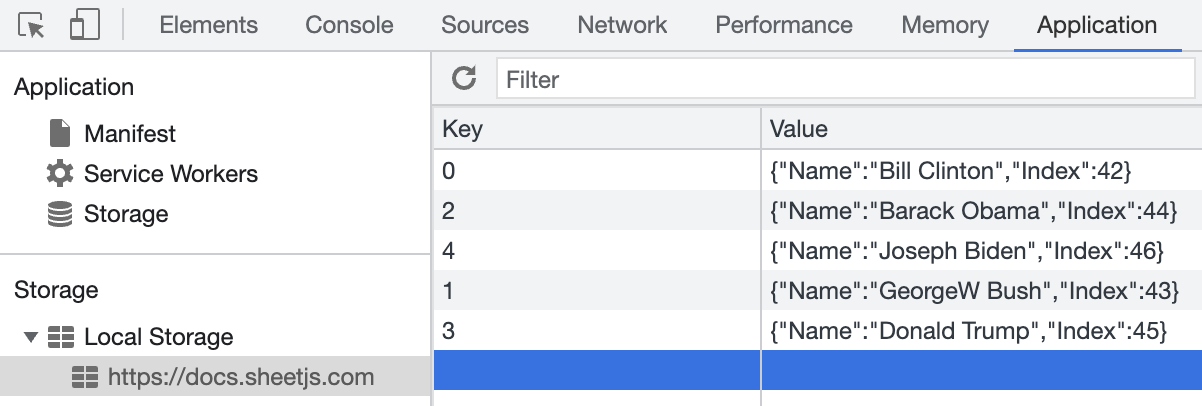Local Storage API
The Storage API, encompassing localStorage and sessionStorage, describes
simple key-value stores that only support string values and keys.
This demo covers two common use patterns:
- "Row Objects" shows a simple convention for loading and storing row objects.
- "Simple Strings" discusses how to persist and recover keys and string values.
Each browser demo was tested in the following environments:
| Browser | Date |
|---|---|
| Chromium 136 | 2025-05-21 |
| Safari 18.2 | 2025-05-21 |
| Konqueror 22 | 2025-04-23 |
Row Objects
Consider the following array of objects of data:
[
{ Name: "Barack Obama", Index: 44 },
{ Name: "Donald Trump", Index: 45 },
{ Name: "Joseph Biden", Index: 46 }
]
Storage API expects values to be strings. The simplest approach is to generate
strings using JSON.stringify and store using the row index as a key:
| Key | Value |
|---|---|
| 0 | {"Name":"Barack Obama","Index":44} |
| 1 | {"Name":"Donald Trump","Index":45} |
| 2 | {"Name":"Joseph Biden","Index":46} |
Importing Data
localStorage.setItem will store data in Local Storage.
Starting from a worksheet, the SheetJS sheet_to_json method1 generates an
array of row objects. Each object in the array can be saved in the Local Storage
using the row index as the key.
function sheet_to_localStorage(worksheet) {
const aoo = XLSX.utils.sheet_to_json(worksheet);
for(let i = 0; i < aoo.length; ++i) {
localStorage.setItem(i, JSON.stringify(aoo[i]));
}
}
Exporting Data
localStorage.length returns the total number of entries. A simple for loop
can cover the keys (integers from 0 to localStorage.length - 1 inclusive)
localStorage.getItem will load the stringified data from the Local Storage.
The following function collects data from localStorage to an array of strings:
function localStorage_to_array_of_strings() {
const strings = [];
for(let i = 0; i < localStorage.length; ++i) {
aoo.push(localStorage.getItem(i));
}
return strings;
}
Since each entry is a string created using JSON.stringify, an object can be
constructed using JSON.parse:
function localStorage_to_array_of_objects() {
const objects = [];
for(let i = 0; i < localStorage.length; ++i) {
aoo.push(JSON.parse(localStorage.getItem(i)));
}
return objects;
}
The SheetJS json_to_sheet2 method will create a new worksheet from the
array of objects:
function localStorage_to_sheet() {
const aoo = [];
for(let i = 0; i < localStorage.length; ++i) {
aoo.push(JSON.parse(localStorage.getItem(i)));
}
return XLSX.utils.json_to_sheet(aoo);
}
Live Demo
This demo will fetch https://docs.sheetjs.com/pres.numbers, fill localStorage
with rows, then generate a worksheet from the rows and write to a new file.
After saving the exported file, the Local Storage can be inspected in the "Local Storage" section of the "Application" Tab of Developer Tools:

This example is for illustration purposes. If an array of objects is available, it is strongly recommended to convert that array to a worksheet directly.
Live Demo (click to show)
function SheetJStorage() { const [url, setUrl] = React.useState("https://docs.sheetjs.com/pres.numbers"); const set_url = (evt) => setUrl(evt.target.value); const [out, setOut] = React.useState(""); const xport = React.useCallback(async() => { // get first worksheet data as array of objects const wb = XLSX.read(await (await fetch(url)).arrayBuffer()); const aoo = XLSX.utils.sheet_to_json(wb.Sheets[wb.SheetNames[0]]); // reset and populate localStorage localStorage.clear(); for(var i = 0; i < aoo.length; ++i) localStorage.setItem(i, JSON.stringify(aoo[i])); // create new array of objects from localStorage const new_aoo = []; for(var i = 0; i < localStorage.length; ++i) { const row = JSON.parse(localStorage.getItem(i)); new_aoo.push(row); } setOut(`Number of rows in LocalStorage: ${localStorage.length}`); // create and export workbook const new_ws = XLSX.utils.json_to_sheet(new_aoo); const new_wb = XLSX.utils.book_new(); XLSX.utils.book_append_sheet(new_wb, new_ws, "Sheet1"); XLSX.writeFile(new_wb, "SheetJStorage.xlsx"); }); return ( <> {out && ( <><a href={url}>{url}</a><pre>{out}</pre></> )} <b>URL: </b><input type="text" value={url} onChange={set_url} size="50"/> <br/><button onClick={xport}><b>Fetch!</b></button> </> ); }
Simple Strings
The "Row Objects" approach is strongly recommended when trying to store or recover arrays of row objects.
When the goal is to save an existing Storage, the general representation is an array of pairs. Consider the following data in Local Storage:
| Key | Value |
|---|---|
| "b" | "Logical" |
| "n" | "Numeric" |
| "s" | "Textual" |
The natural representation is an array of arrays:
[
[ "b", "Logical" ],
[ "n", "Numeric" ],
[ "s", "Textual" ]
]
Exporting Storage
Web Storage iteration order is not defined. By using indices as keys, the row objects approach has an ordering. That does not apply to the general case.
In modern browsers, Object.entries will generate an array of key/value pairs.
The SheetJS aoa_to_sheet3 method will interpret that array as a worksheet
with 2 columns (key and value):
function localStorage_to_ws() {
const aoa = Object.entries(localStorage);
return XLSX.utils.aoa_to_sheet(aoa);
}
Importing Storage
In the other direction, the worksheet is assumed to store keys in column A and
values in column B. The SheetJS sheet_to_json1 method, with the option
header: 1, will generate key/value pairs that can be assigned to a storage:
function ws_to_localStorage(ws) {
const aoa = XLSX.utils.sheet_to_json(ws, { header: 1 });
aoa.forEach(([key, val]) => localStorage.setItem(key, val));
}
Live Demo
This example fills localStorage with 10 random keys and 10 random values,
generates a worksheet from the data and writes to a new file.
Live Demo (click to show)
function SheetJSRandomStorage() { const [out, setOut] = React.useState(""); const [rows, setRows] = React.useState([]); const xport = React.useCallback(async() => { // reset and populate localStorage localStorage.clear(); var data = []; for(let i = 0, last = 0; i < 10; ++i) { var k = ((Math.random() * 20)|0) + last; var v = (Math.random() * 16777216).toString(36); localStorage.setItem(k, v); data.push([k,v]); last = k; } setRows(Object.entries(localStorage)); // create new worksheet from localStorage const aoa = Object.entries(localStorage); const new_ws = XLSX.utils.aoa_to_sheet(aoa); // create and export workbook const new_wb = XLSX.utils.book_new(); XLSX.utils.book_append_sheet(new_wb, new_ws, "Sheet1"); XLSX.writeFile(new_wb, "SheetJSRandomStorage.xlsx"); }); return ( <> {out && ( <><a href={url}>{url}</a><pre>{out}</pre></> )} {rows.length && (<table><tr><th>Key</th><th>Value</th></tr> {rows.map(([k,v]) => (<tr><td>{k}</td><td>{v}</td></tr>))} </table>) || null} <br/><button onClick={xport}><b>Export!</b></button> </> ); }